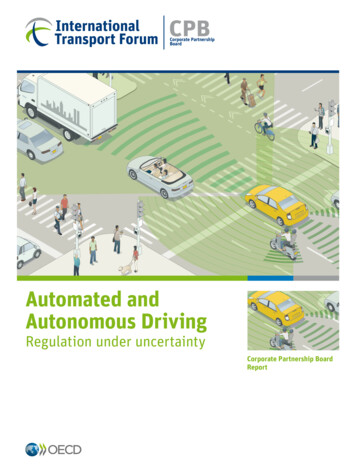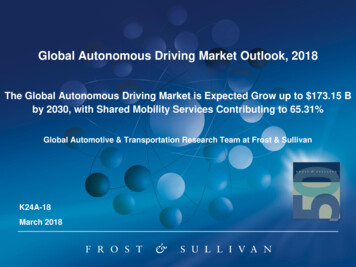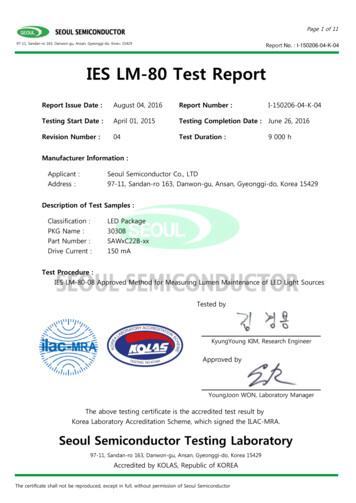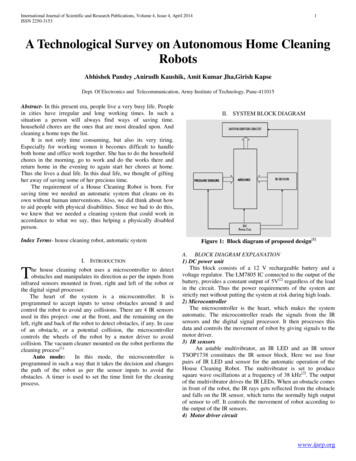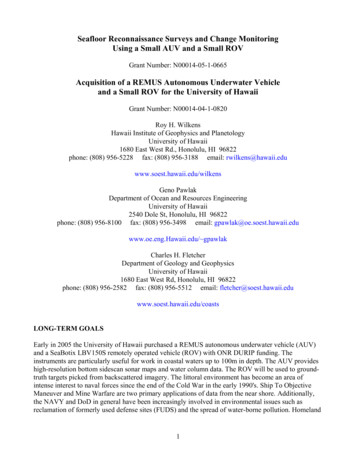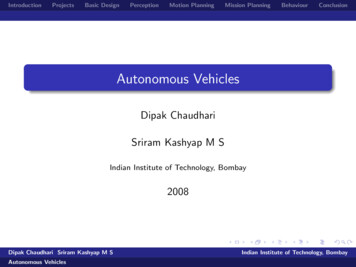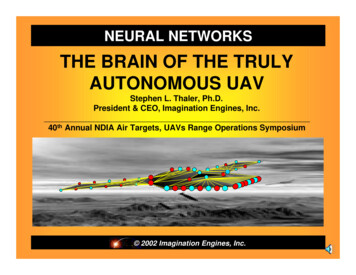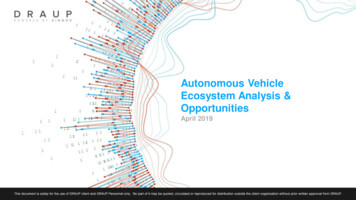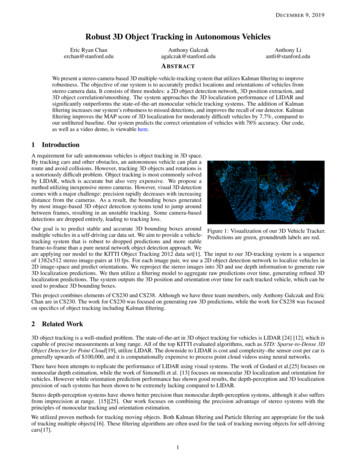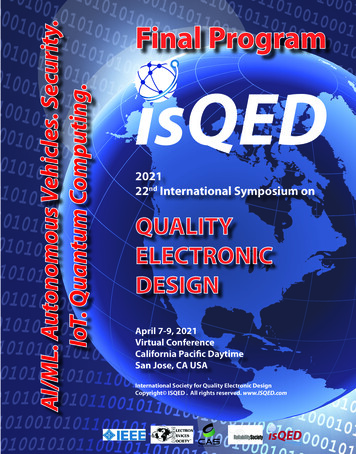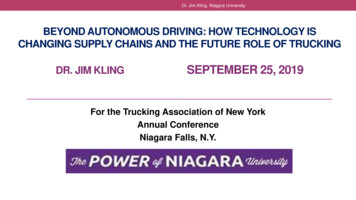
Transcription
Dr. Jim Kling, Niagara UniversityBEYOND AUTONOMOUS DRIVING: HOW TECHNOLOGY ISCHANGING SUPPLY CHAINS AND THE FUTURE ROLE OF TRUCKINGDR. JIM KLINGSEPTEMBER 25, 2019For the Trucking Association of New YorkAnnual ConferenceNiagara Falls, N.Y.
Dr. Jim Kling, Niagara University
Dr. Jim Kling, Niagara UniversityNiagara University Supply Chain Programs 6 Course Undergraduate Concentration in ManagementSupply Chain Logistics, Operations, Transportation, Global SCM,Procurement and Cases/Technology/Seminar. MBA Concentration in Global Business and Supply Chain Management NU Center for Supply Chain Management Excellence: 5 Day Certificate Program, May Logistics Costs and Trend Updates-Breakfast at NU: January and June Customized Corporate Training Jack Ampuja, Executive in Residence, CEO of Supply Chain Optimizers
Dr. Jim Kling, Niagara UniversityThe Dilemma of Technology.How and When will it Help? A recent logistics report used all these acronyms on one page: AI, ML, IoT AR, VR, Blockchain: I am not going to talk much about any of these things. New technology is fun, but we have a business to run Also, the Educator’s DilemmaMany Sources
Dr. Jim Kling, Niagara UniversityInstead, try to focus on technologies that areimpacting trucking and the supply chain . Energy and Electric Vehicles E-Commerce Autonomous Driving Vehicles The Gig Economy 3D Printing, and on-demand delivery A near term vision for our future transportation network What is the #1 Technology that benefited the U.S.trucking industry in the last ten years?
Dr. Jim Kling, Niagara UniversitySeptember 2019Saudi Arabian oil facilities attacked5% of World oil production off line.
Dr. Jim Kling, Niagara UniversityNo CrisisNo 100 OilNo 5 DieselDemand for U.S.fuel products Downover last 15 yearsPeak Oil?FrackingTechnology5 mil. to 12.4 mil mbpd
Battery Technology Advancing RapidlyElectric vs. Diesel Engine Maintenance?Dr. Jim Kling, Niagara University
Dr. Jim Kling, Niagara UniversityE-COMMERCE Transportation Challenges: Final Mile Costs Seasonality Larger Products Need for Speed Amazon.com as Competitor
Dr. Jim Kling, Niagara UniversityAutonomous Driving Update (TTnews.com) No magic bullet for truck driver shortage “Level 2” trucks—lane keeping assist and auto-braking and acceleration Coming within the next 12 months, Safety advantage and driver convenience, but still hands on. No labor savings, so ROI?Level 3 perceived as dangerous—nearly full automation 95%, driver mustbe ready to re-engage.Level 4 FULLY automated, but still accommodates a driver.Level 5 No human controls.
Dr. Jim Kling, Niagara UniversityThe Three biggest issues with autonomous vehicles 1. Weather: Snow, heavy rain, poor infrastucture 2. Legal and Regulatory. Lots of new laws need to be passed inour politicized world, and legal liability must be somewhat limitedfor the technology and truck producers. 3. Hacking and cyber terrorismFor now, invest in electricvehicle technology
Dr. Jim Kling, Niagara UniversityThe GIG ECONOMY, i.e. UBER and Uber freightPer Google, the definition of ‘Gig Economy’is:“a labor market characterized bythe prevalence of short-termcontracts or freelance work asopposed to permanent jobs.” Important part of our new supplychains Tractor-Trailer Owner Operators Final Mile Delivery Uber Freight, a 3PL Broker, hadrevenue of over 300 million in 2018. The Gig economy allowstremendous flexibility for bothworkers and employers, but can itsupport people full time? California as of September 20, 2019passed a law essentially requiringfirms like Uber, Lyft, and Door Dashto make their workers “employees”and thus requiring benefits such asdisability pay and other workerprotections. Some basic level of nationalhealthcare would help accelerate theGig Economy.
Dr. Jim Kling, Niagara University3D PRINTING—Spare parts and more. The future of spare parts fulfillment willincreasingly be in 3-D printing, which.“finds its value in the printing of lowvolume, customer-specific items, itemsthat are capable of much greatercomplexity than is possible throughtraditional means . This at once eliminates the need forboth high volume production facilitiesand low level assembly workers,thereby cutting out at least half of thesupply chain in a single blow.” SOURCE: Cerasis
Dr. Jim Kling, Niagara UniversityWhere will the Inventory be located?This will determine what freight flows look like. The traditional supply chain with Brick and Mortar companies: FTL to RDC, FTL to stores, customers are the pickers and final mile.The E-Commerce supply chain: FTL to DC, then parcel to customer via final mile, but one/same delivery means: FTL to DC, FTL to RDC, parcel to customer via final mile (FTL pallet or pieces?) Replacing customers with pickers and final mile delivery especially problematic for food What’s next? Zume Pizza California.Google “Jim Cramer Zume Pizza” Highly automated but customized Pizzas are baked in the truck en route to delivery. Imagine top 10 Amazon SKUs: Always on the truck?
Dr. Jim Kling, Niagara UniversityThe future supply chain and autonomous vehicles? As we have seen, supply chains evolve: Let’s try to imagine: Platooning—Automated trucks following one driver on long distance ruralroutes. Then where should DCs be located? Repetitive Feeder routes—during the night, loaded electric vehicles drivingto their final mile driver, then the driver doing actual delivery. Drones? Should there be a CDL.2 license for Gig workers driving box trucks on 200400 mile round trips? Electric trucks Should we consider Gig drivers/workers/managers to give them time offduring non peak seasons?
Dr. Jim Kling, Niagara UniversityQuestions you should be asking? How will we participate in final mile solutions? Storage of high volume items? Inside delivery and set-up of large items? Peak demand services? Do we have lanes that could support electric trucks? Could we set up routine autonomous vehicle lanes/platooning ? How can we leverage the Gig economy?
Dr. Jim Kling, Niagara UniversityYour Questions? Thank You! jkling@Niagara.edu
Instead, try to focus on technologies that are impacting trucking and the supply chain . Energy and Electric Vehicles E-Commerce Autonomous Driving Vehicles The Gig Economy 3D Printing, and on-demand delivery A near term vision for our future transportation network What is the #1 Technology that be
